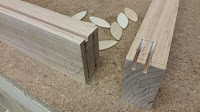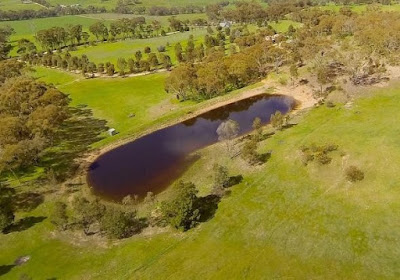The workshop focused on how water can erode a landscape and what actions we can take to control this powerful eroding force.
Water is destructive
Our visit to a member's property showed us several problems that have been caused historically by deforestation due to gold mining as well as stock grazing and general land clearing.The lack of plants has one significant effect, erosion, which is caused by the inability of the terrain to slow down the water as it descends the natural catchment areas.
Water travelling at speed has two flow-on effects (grown... pun) - erosion and lack of ground penetration. Both prevent the germination of plants - our ideal warrior against this foe.
The signs of erosion to look for on your property are:
- Tunnelling - water concentrates its force and erodes a hole under the ground, similar to the effect a garden hose would have at high pressure
- Capping - where the ground is completely free of vegetation and therefore highly susceptible to erosion
- Blow-out - where an earth wall has been built to contain the water, such as in a dam, but where the engineering has failed when exposed to high water volumes
- Gullys - water has descended a hill or natural depression at high speed and eroded the ground to form a deep gully
 |
| Gully erosion in the Muckleford forest |
Erosion prevents natural landscape recovery
Nearly all these problems prevent the resowing or germination of any plant species, including grasses, making this a continuous issue which, if left unmanaged, will result in dirt and sediment continuing to contaminate the existing waterways which feed the local drinking water and provide irrigation for farmers.
While major erosion, such as gullys, is an obvious symptom, the problem of "capping" is wide-spread across many properties and should be drawn to the attention of any conscientious land holder.
 |
| Capped area with preventative measures |
Taking a whole-of-landscape approach
The natural tendency when looking to solve the problems of erosion is to tackle the obvious issues first, such as the gullys, however, these bigger symptoms are caused by the end result of water cascading down a catchment area and gathering speed, often over capped, bare ground.
To deal with downstream erosion we need to lift our gaze higher up the catchment area and observe the landscape to identify points which cause the water to speed up.
There can also be a tendency when dealing with major erosion to bring in earth moving equipment and attempt to address the issue (or symptom) by major reworking of the area.
By dealing with symptoms we can incur significant cost, disturb the ground causing even more erosion and, fundamentally, not address the core problems.
Slowing the water
To prevent water forming powerful channels and eroding our farms we need to disperse the flow. By spreading out the flow over a wider area we can address the two major issues of speed and ground penetration.
A cost-effective, although time-consuming approach that any landholder can apply is to use local materials to help disperse the water. Branches laid across the water's course, up-stream of capped areas, can disperse the water. As this process is repeated down a hill, the cumulative effect can be greatly enhanced.
 |
| Dispersing water with branches (and a native animal) |
We are not trying to dam the water as solid structures will likely be washed away in the next big downpour. Instead a loose collection of twigs and branches is sufficient to break the flow of the water and create calm areas in which plants can self-sow and begin the restoration process.
Time and patience
The approach above does rely on a fair amount of work and then time to come to fruition. The above photo shows a treatment that took four hours a day for four months. Once stick at a time!
Over time the treated areas will naturally attract sediment and plant matter, creating ideal seeding zones for self-sown plants as well as the opportunity for tube-stock planting.
We would expect to wait approximately two years before assessing the effect of the treatment prior to any type of planting intervention. Many landscapes can recover by themselves once they are given the opportunity.
Key workshop take-aways
- Take a whole-of-landscape approach
- Tackle the sickness, not the symptom
- Don't jump straight on to the big problems first
- Start your treatments higher up the catchment zone and work down
- Expensive treatments are not always the best
- Do a little every day
- Be patient
Thanks again to everyone at the workshop for their time and energy. Happy landscaping!





















































